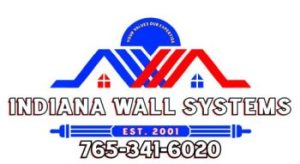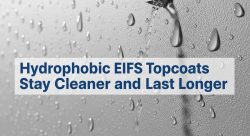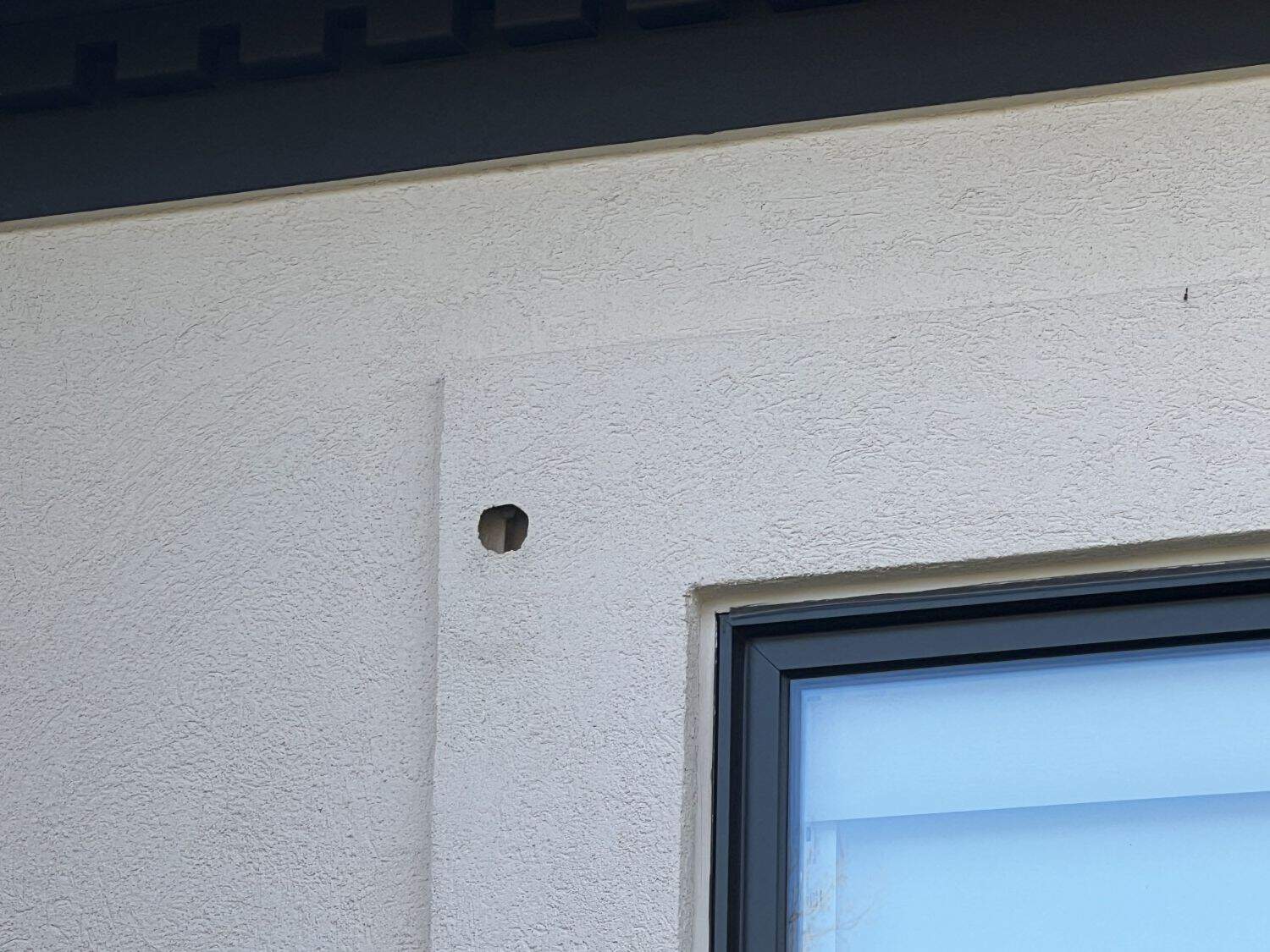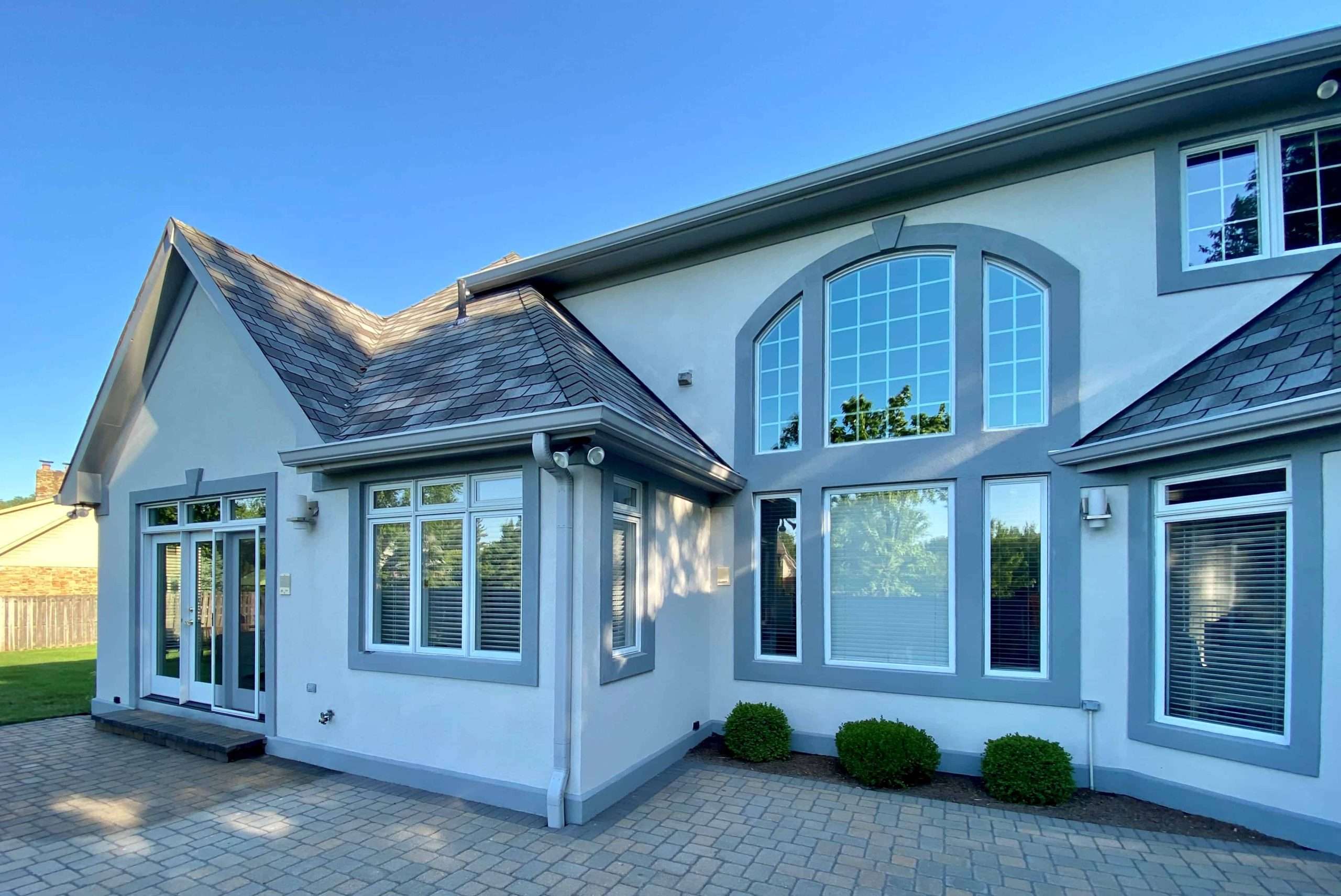Detect and Prevent Landscaping Damage to EIFS with Seasonal Checks and Smart Design
When Jeff Johnson first started Indiana Wall Systems 22 years ago, he noticed a troubling pattern. Beautiful EIFS (Exterior Insulation and Finish System) installations were failing prematurely—not from poor workmanship or material defects, but from preventable landscaping mistakes.
“The saddest thing I see is perfect EIFS work destroyed by sprinklers hitting the wall daily,” Jeff explains. “Homeowners spend thousands on professional installation, then unknowingly create conditions that allow water infiltration and costly repairs.”
EIFS landscaping damage prevention isn’t complicated, but it requires understanding how your yard maintenance practices affect your wall system. This guide covers the most common landscaping hazards and practical solutions to protect your investment.
Key Takeaways
- Sprinkler overspray causes 60% of preventable EIFS moisture damage in residential applications
- Soil contact with cladding creates wicking pathways that bypass the system’s moisture barriers
- Simple barrier materials and proper grading can eliminate most landscaping-related EIFS problems
- Regular irrigation inspections prevent minor adjustments from becoming major repair projects
- Professional EIFS contractors can identify vulnerable areas during routine maintenance visits
How Landscaping Destroys EIFS Systems
Leading Causes of EIFS Damage
What threatens your exterior insulation system most
Sprinkler overspray alone causes 6 out of 10 preventable EIFS failures. Simple adjustments save thousands in repairs.
Stop Sprinkler Damage Before It Starts
Professional irrigation assessment identifies and fixes problem areas
Call (765) 341-6020 Free InspectionUnderstanding common EIFS problems starts with recognizing how water infiltration occurs around your home’s exterior. Unlike traditional stucco, EIFS relies on specific moisture management principles that landscaping can easily compromise.
The Hidden Dangers of Irrigation Systems
Sprinkler systems pose the greatest threat to EIFS integrity. When water repeatedly hits the finish surface, several problems develop:
Direct Water Penetration: Constant moisture exposure overwhelms the system’s ability to dry out between watering cycles. This creates conditions for water infiltration damage behind the EIFS.
Finish Deterioration: High-pressure sprinkler spray gradually breaks down the protective finish coat, creating microscopic openings that allow moisture entry.
Staining and Discoloration: Irrigation overspray staining from dissolved minerals creates unsightly marks that resist conventional cleaning methods.
Soil Contact Problems
Soil contact with cladding creates several pathways for moisture problems:
- Capillary Action: Soil touching the EIFS surface allows water to wick directly into the system
- Freeze-Thaw Damage: Moisture trapped at the soil line expands during winter, causing cracks and separation
- Biological Growth: Constant moisture from soil contact promotes algae streaking near soil and other organic growth
Landscaping Tool Damage
Daily yard maintenance can gradually damage EIFS surfaces through:
- String trimmer damage from nylon cutting lines hitting the wall
- Mower discharge spray propelling grass clippings and debris against the surface
- Hedge trimmer contact during shrub maintenance near walls
- Weed trimmer nicks that compromise the protective finish layer
Smart Irrigation Design for EIFS Protection
Protecting your EIFS system starts with intelligent landscape irrigation design. Jeff Johnson’s team regularly consults with irrigation contractors to prevent common installation mistakes.
Sprinkler Placement Guidelines
Minimum Distance Requirements: Install sprinkler heads at least 18 inches from EIFS walls. This distance prevents direct water impact while ensuring adequate lawn coverage.
Spray Pattern Adjustment: Configure rotor vs spray head irrigation systems to minimize wall contact:
EIFS Sprinkler Distance Guide
Interactive tool for safe irrigation placement
This distance creates high risk of water infiltration and EIFS damage. Adjust sprinkler placement immediately.
This distance provides adequate protection while maintaining effective irrigation coverage.
💡 Pro Installation Tips
- 1Use a measuring tape to verify exact distances before finalizing sprinkler positions
- 2Install rain sensors to prevent unnecessary watering during humid Indiana weather
- 3Schedule irrigation for early morning (4-6 AM) to allow surfaces to dry completely
- 4Adjust spray patterns seasonally as plants grow and coverage needs change
- 5Consider drip systems for planting beds within 36 inches of EIFS walls
Need Professional Irrigation Assessment?
Our EIFS experts work with irrigation contractors to ensure your system protects your investment
Advanced Irrigation Controls
Modern smart irrigation controllers offer precise water management that protects EIFS:
Rain Sensors: Automatically skip watering cycles during wet weather, reducing oversaturation near foundations.
Weather-Based Scheduling: Adjusts watering duration and frequency based on local weather data, preventing overwatering during humid periods.
Zone Management: Allows different watering schedules for areas near EIFS walls versus open lawn spaces.
Proper Drainage Design
Effective drainage systems prevent water accumulation that threatens EIFS integrity:
Surface Runoff Control: Grade landscapes to direct water away from walls using:
- Drainage swales that channel water to appropriate outlets
- French drain installation for areas with persistent moisture problems
- Subsurface drainage tile to manage groundwater issues
Creating Protective Barriers and Buffer Zones
Landscape barrier materials provide physical protection between your yard and EIFS cladding. These solutions prevent direct contact while maintaining attractive landscaping.
Physical Barrier Options
Gravel Buffer Strips: Install 6-12 inch wide gravel beds along EIFS walls. Benefits include:
- Prevents soil-to-wall contact
- Provides excellent drainage
- Creates clean, maintenance-friendly borders
- Available in decorative colors and textures
Stone Edging Systems: Professional landscaping edging separation gaps using natural stone or manufactured materials:
- Maintains 4-6 inch clearance from wall surface
- Allows air circulation behind plantings
- Provides durable, long-term protection
- Complements various architectural styles
Vegetation Management
Proper plant selection and placement prevents moisture problems:
Shrub Placement Guidelines: Position shrubs at least 24 inches from EIFS surfaces to allow air circulation and prevent shrubbery moisture traps.
Groundcover Selection: Choose plants that don’t require frequent watering near walls:
- Drought-tolerant perennials
- Native grasses with deep root systems
- Ornamental plants adapted to local climate conditions
Mulch and Soil Management
Mulch application affects EIFS moisture levels significantly:
Safe Mulching Practices:
- Keep mulch 6 inches away from wall surfaces
- Use stone mulch vs wood mulch in high-moisture areas
- Limit mulch depth to 2-3 inches maximum
- Choose materials that don’t retain excessive moisture
Soil Grade Management: Maintain proper grading that slopes away from foundations:
- 6 inches drop over first 10 feet from wall
- Address foundation backfill settlement issues promptly
- Install erosion control mats on steep slopes
Seasonal Maintenance and Protection Strategies
EIFS Seasonal Maintenance Guide
Essential tasks to protect your EIFS system year-round
Spring Tasks (March – May)
Professional EIFS Maintenance
Stay ahead with expert seasonal care from Indiana Wall Systems
Call (765) 341-6020 View GuideSeasonal yard care requires adjusting practices to protect your EIFS installation throughout Indiana's changing weather patterns.
Spring Preparation
Early Season Checklist:
- Sprinkler system inspection for winter damage
- Irrigation leak detection around foundation areas
- Mulch refresh with proper wall clearances
- Drainage inspection of swales and collection points
Sprinkler Head Maintenance: Winter freeze-thaw cycles often shift sprinkler head positions. Verify all heads maintain proper distance and spray patterns away from EIFS surfaces.
Summer Care Protocols
Heat Season Challenges: High temperatures and humidity create unique EIFS maintenance requirements:
Watering Schedule Adjustments: Reduce automatic irrigation cycles during humid periods when moisture problems develop more easily behind EIFS.
Vegetation Growth Control: Trim shrubs and plants before they contact wall surfaces. Vine growth against walls creates moisture traps and can damage the finish surface.
Fall and Winter Protection
Cold Weather Preparation prevents freeze-thaw damage:
Drainage Clearance: Remove leaf mulch accumulation from foundation areas that can trap moisture against EIFS walls.
Snow Management: Plan for snow pile splashback by designating areas away from walls for snow storage.
Gutter Maintenance: Clean clogged gutters that cause ice dam overflow paths onto EIFS surfaces.
Professional Maintenance and Inspection Guidelines
Regular EIFS inspections identify landscaping-related problems before they require extensive damage repairs. Jeff Johnson recommends specific inspection intervals based on landscaping complexity.
Annual Inspection Items
Professional EIFS inspectors examine these landscaping-related areas:
- Sprinkler Overspray Evidence: Look for staining, finish deterioration, or soft spots indicating water infiltration
- Soil Contact Points: Check for mulch piled against finish or grade sloping toward wall
- Drainage Function: Verify surface runoff control systems work properly
- Barrier Integrity: Inspect gravel buffer strips and edging materials
When to Call Indiana Wall Systems
Contact certified EIFS contractors immediately if you notice:
- Soft or spongy areas when pressing on EIFS surface
- Discoloration or staining that doesn't clean with gentle washing
- Cracks or gaps where landscaping materials contact the wall
- Standing water at the base of EIFS walls after irrigation or rain
Professional assessment prevents minor landscaping issues from becoming structural damage requiring expensive EIFS repair or EIFS removal.
Advanced Protection Strategies
Modern EIFS systems benefit from advanced protection technologies that work alongside smart landscaping practices.
Smart Technology Integration
IoT-Based Monitoring: Install moisture sensors at critical points around your EIFS home to detect water intrusion before damage occurs.
Automated Irrigation Management: Weather-based irrigation scheduling systems adjust watering based on:
- Real-time soil moisture readings
- Local weather forecasts
- Seasonal plant requirements
- EIFS-specific moisture limits
Commercial Applications
Property managers overseeing EIFS cladding on commercial buildings face unique challenges:
Large-Scale Irrigation Systems: Commercial properties require:
- Professional irrigation contractor oversight for system design
- Regular sprinkler arc adjustment to accommodate building additions
- Zone irrigation near structures with specialized controllers
Landscape Contractor Coordination: Establish landscaping contractor best practices including:
- EIFS-specific training for maintenance crews
- Equipment protocols that prevent accidental damage
- Communication procedures for reporting potential problems
Cost Analysis: Prevention vs. Repair
Understanding the financial impact of EIFS landscaping damage prevention helps justify protective measures.
Prevention Costs vs. Repair Expenses
EIFS Protection Investment Analysis
Prevention costs vs. potential repair expenses
Protect Your EIFS Investment Today
Smart prevention saves thousands. Get your custom protection plan.
Call (765) 341-6020 for Free ConsultationReturn on Investment: Preventive measures typically cost 10-15% of repair expenses while providing 20+ years of protection.
Hidden Costs of Neglect
Ignoring landscaping hazards creates cascading problems:
- Initial Surface Damage: $500-2,000 for finish repairs
- Water Infiltration Issues: $2,000-8,000 for substrate replacement
- Structural Problems: $5,000-15,000+ for wall system rebuilds
- Insurance Complications: Many policies exclude gradual water damage from poor maintenance
Regional Considerations for Indiana Properties
Central Indiana's climate creates specific challenges for EIFS landscaping damage prevention.
Weather-Specific Strategies
Seasonal Moisture Patterns: Indiana's humid summers and freeze-thaw winters require:
- Enhanced drainage systems for spring snowmelt
- Summer humidity management through proper air circulation
- Fall preparation protocols for leaf management
- Winter protection from ice dam formation
Soil Conditions: Indiana's clay-heavy soils affect foundation drainage design:
- Slower percolation rates require enhanced surface drainage
- Expansion/contraction cycles need flexible barrier systems
- Seasonal saturation periods require temporary protection measures
Local Plant Considerations
Native Indiana vegetation offers EIFS-compatible landscaping options:
Low-Water Plants: Species adapted to local rainfall patterns reduce irrigation requirements near EIFS walls.
Seasonal Growth Patterns: Choose plants with predictable growth cycles that don't surprise homeowners with rapid expansion toward walls.
Common Mistakes and How to Avoid Them
Jeff Johnson's experience reveals the most frequent landscaping mistakes that damage EIFS systems.
Installation Errors
Sprinkler System Mistakes:
- Installing heads too close to walls during initial landscape design
- Failing to adjust spray patterns after EIFS installation
- Using high-pressure nozzles inappropriate for proximity to walls
Drainage Design Flaws:
- Improper grading that directs water toward foundations
- Inadequate downspout discharge planning
- Missing French drain systems in problem areas
Maintenance Oversights
Seasonal Neglect:
- Allowing mulch buildup against wall surfaces
- Ignoring sprinkler drift during dry periods
- Postponing drainage maintenance until problems develop
Equipment Misuse:
- Power washing EIFS surfaces with inappropriate pressure
- Using metal landscape edging that can scratch finish surfaces
- String trimmer contact during routine lawn maintenance
Professional Solutions and Expert Services
Indiana Wall Systems offers comprehensive EIFS protection services beyond basic installation and repair.
Consultation Services
Pre-Landscape Planning: Work with homeowners and landscape designers to create EIFS-compatible outdoor spaces:
- Irrigation system design review before installation
- Drainage planning that protects wall systems
- Plant selection guidance for moisture-sensitive areas
Existing Landscape Assessment: Evaluate current landscaping for EIFS hazards:
- Sprinkler pattern analysis and adjustment recommendations
- Drainage effectiveness evaluation and improvements
- Barrier installation planning and implementation
Ongoing Maintenance Programs
Annual Protection Plans:
- Professional EIFS inspections with landscaping focus
- Seasonal maintenance reminders for property owners
- Priority service for landscape-related EIFS problems
Emergency Response: 24/7 availability for irrigation leak emergencies affecting EIFS systems.
Frequently Asked Questions
How far should sprinklers be from EIFS walls?
Maintain at least 18-24 inches between sprinkler heads and EIFS surfaces. This distance prevents direct water impact while ensuring adequate irrigation coverage. Adjust spray patterns to create 180-degree arcs that avoid wall contact entirely.
Can I plant shrubs directly against EIFS?
Never plant shrubs against EIFS surfaces. Maintain minimum 24-inch clearance to allow air circulation and prevent moisture accumulation. Use decorative barriers like gravel strips or stone edging to maintain attractive transitions between landscaping and walls.
What mulch is safe to use near EIFS?
Keep all mulch 6+ inches away from EIFS surfaces regardless of type. Stone mulch offers better drainage than wood products, but distance matters more than material choice. Limit mulch depth to 2-3 inches maximum near walls.
How do I fix irrigation stains on EIFS?
Professional cleaning using EIFS-compatible solutions removes most irrigation stains without damaging the finish. Never use pressure washing or abrasive cleaners. Contact certified EIFS contractors for persistent staining that resists gentle cleaning methods.
Should I waterproof EIFS exposed to irrigation?
Proper system design eliminates the need for additional waterproofing. Focus on preventing water contact through smart irrigation placement, drainage management, and protective barriers rather than attempting to seal the system against inevitable moisture exposure.
When should I inspect EIFS for landscape damage?
Schedule professional inspections annually, with additional checks after severe weather or landscape changes. Look monthly for obvious problems like soft spots, staining, or standing water near foundations that require immediate attention.
Can landscaping void my EIFS warranty?
Improper landscaping practices may void warranties if they cause preventable damage. Follow manufacturer guidelines for clearances, drainage, and maintenance. Document protective measures and professional inspections to maintain warranty coverage.
What's the most common landscape damage to EIFS?
Sprinkler overspray causes approximately 60% of preventable EIFS moisture problems. Simple adjustments to spray patterns, timing, and controller settings eliminate this leading cause of premature system failure and costly repairs.
Conclusion: Protecting Your EIFS Investment Through Smart Landscaping
EIFS landscaping damage prevention requires understanding how your exterior insulation and finish system interacts with yard maintenance practices. The strategies outlined here protect your investment while maintaining beautiful outdoor spaces.
Key protection principles include maintaining proper clearances, managing water effectively, and scheduling regular inspections. These simple practices prevent the common EIFS problems that lead to expensive repairs.
Indiana Wall Systems has spent 22 years helping property owners across central Indiana protect their EIFS investments. Our experience with moisture management techniques and preventive maintenance strategies helps homeowners avoid costly repairs.
Remember: an ounce of prevention is worth a pound of cure. Professional EIFS inspection and smart landscaping practices ensure your EIFS system provides decades of reliable performance.
Ready to protect your EIFS from landscaping damage? Contact Indiana Wall Systems at (765) 341-6020 for expert consultation on EIFS maintenance and protection strategies tailored to your property's unique needs.
Don't let poor landscaping practices destroy your EIFS investment. Call today for a comprehensive evaluation and customized protection plan from Central Indiana's most experienced EIFS specialists.





